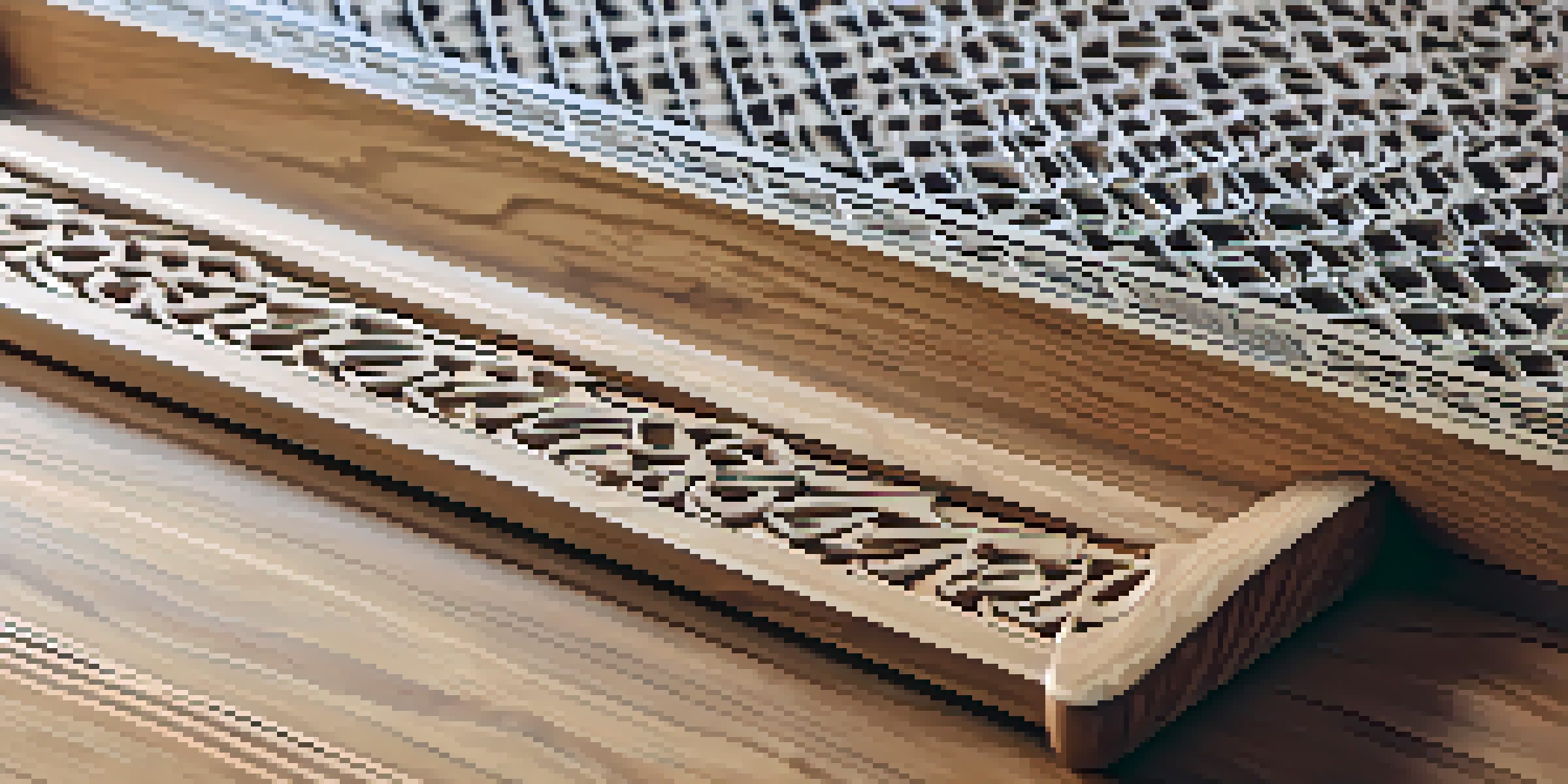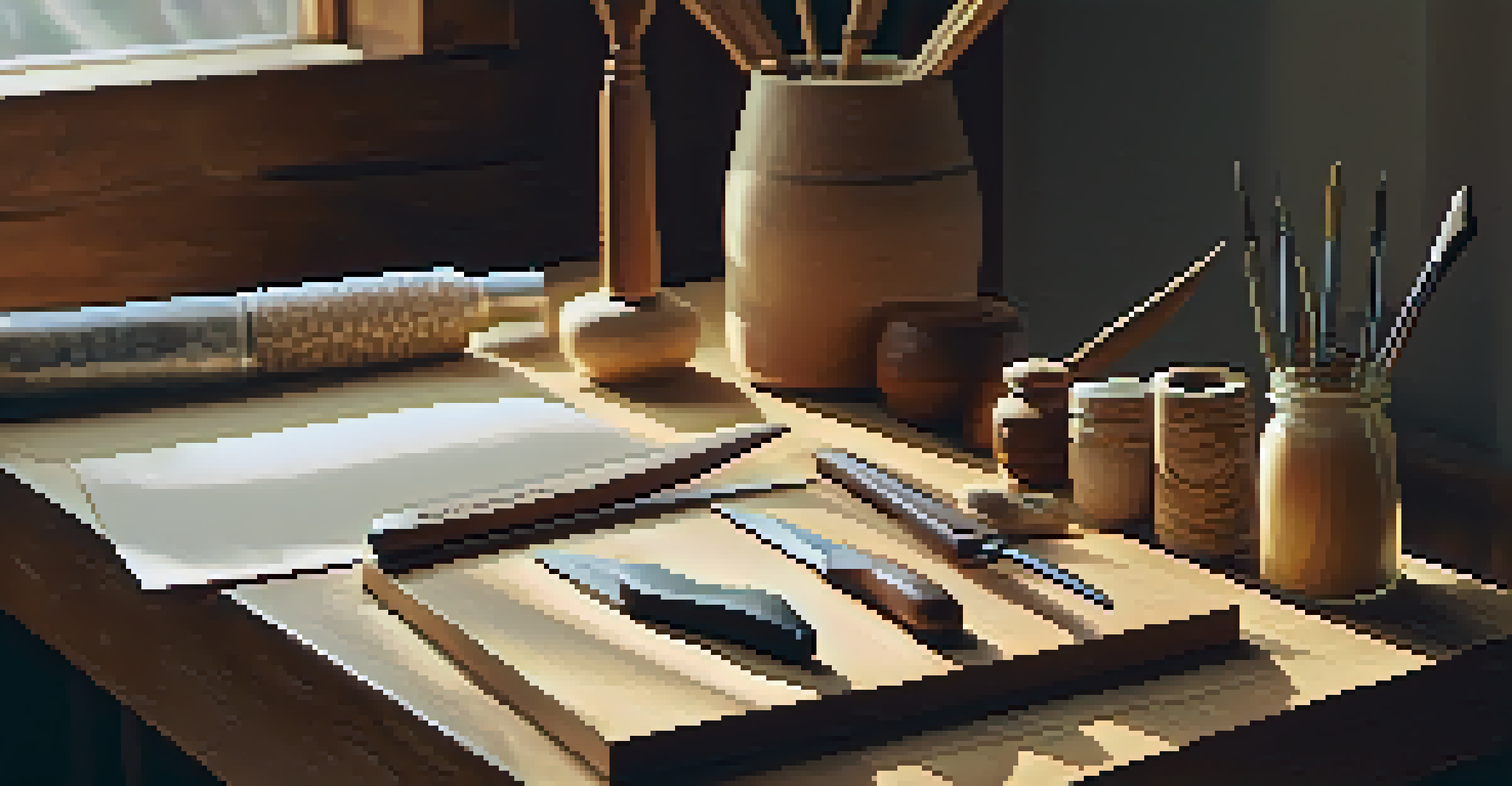Utilizing Chip Carving Techniques for Home Improvement Projects

What is Chip Carving and Its History
Chip carving is a decorative wood carving technique that creates intricate patterns by removing small chips of wood. Originating from Eastern Europe, this craft has evolved over centuries and is celebrated for its beauty and precision. The simplicity of the tools used, mainly a sharp knife, allows both beginners and seasoned artisans to create stunning designs.
Woodworking is not just a craft; it's a way to connect with the past and create something beautiful for the future.
Historically, chip carving was often used to embellish furniture and everyday items, giving them a personal touch. Today, it has seen a resurgence in popularity as crafters seek to add unique character to their home decor. By understanding its roots, we can appreciate the artistry behind each carved piece.
Whether you’re a novice or an expert, chip carving offers a meditative experience that connects you with traditional crafting methods. As you explore this technique, you'll find endless possibilities for incorporating it into your home improvement projects.
Essential Tools for Chip Carving
To get started with chip carving, you'll need a few essential tools. A chip carving knife, which has a short blade and a comfortable handle, is crucial for achieving those delicate cuts. Additionally, a carving glove can protect your hand while you work, ensuring safety as you create designs.

Other tools like a straightedge for guiding your cuts and a sharpening stone for maintaining your knife's edge are also important. Having the right tools not only enhances your skill but also makes the crafting process more enjoyable. Investing in quality tools can make a significant difference in the precision of your work.
Chip Carving: A Craft with Roots
Chip carving is a historical decorative wood technique, celebrated for its intricate designs and personal touches to home decor.
Remember, the right tools can transform your experience from frustrating to fulfilling. As you gather your materials, you'll be inspired to dive deeper into the world of chip carving and unleash your creativity on home improvement projects.
Choosing the Right Wood for Your Projects
Selecting the right type of wood is crucial in chip carving, as different woods yield different results. Softwoods like basswood and pine are popular choices for beginners due to their ease of carving and affordability. These woods are forgiving, allowing you to practice and improve your technique without too much frustration.
The essence of craftsmanship is not in the tools you use, but in the care and creativity you put into your work.
Hardwoods, such as cherry or oak, offer a more challenging experience but can produce stunning results due to their beautiful grain patterns. When choosing wood, consider not only the ease of carving but also how the finished product will look in your home. Each type of wood brings its unique character to your projects.
Ultimately, your choice of wood will influence the aesthetic and durability of your carved items. Take your time to explore different types, and you'll find the perfect match for your chip carving endeavors.
Basic Chip Carving Techniques to Master
Before diving into elaborate designs, it's essential to master basic chip carving techniques. Start with simple shapes like triangles and squares, as they form the foundation for more complex patterns. Practicing these shapes will build your confidence and help you understand the mechanics of your knife.
Once you're comfortable with the basics, you can explore techniques such as V-cutting and stop cuts, which add depth and detail to your designs. These methods allow you to create intricate motifs that can elevate any home decor item. Each technique you learn opens up new creative possibilities.
Essential Tools for Success
Having the right tools, like a chip carving knife and a straightedge, enhances the crafting experience and improves the quality of your work.
As you practice, don’t be afraid to experiment with your designs. The beauty of chip carving lies in its ability to adapt and evolve with your style, so let your creativity flow as you refine your skills.
Incorporating Chip Carving into Home Decor
Chip carving can beautifully enhance your home decor, adding a personal touch that reflects your style. Consider carving designs into wooden trays, picture frames, or even furniture pieces to make them uniquely yours. These items not only serve practical purposes but also become conversation starters.
You can also create wall art by carving intricate patterns into wooden panels, allowing you to infuse your space with warmth and character. The tactile quality of carved wood brings a sense of craftsmanship that enhances any room. Each piece you create acts as a testament to your creativity and effort.
Moreover, chip carving can be a wonderful way to gift personalized items to friends and family. Handcrafted gifts carry a special meaning, and your carved creations will surely be cherished for years to come.
Maintaining Your Chip Carved Projects
Once you've completed your chip carving projects, proper maintenance is essential to ensure their longevity. Begin by applying a food-safe finish if your piece will be used for dining or food-related purposes. This not only protects the wood but also enhances its natural beauty.
Regular cleaning with a soft cloth will help maintain the appearance of your carved items. Avoid harsh chemicals, as they can damage the wood and finish. Instead, opt for gentle soap and water when necessary, ensuring your pieces remain in top condition.
Wood Selection Matters
Choosing the appropriate wood type is crucial, as it affects the ease of carving and the final aesthetic of your projects.
Lastly, store your carved items in a cool, dry place to prevent warping or cracking. With the right care, your chip carved projects can bring joy and beauty to your home for many years.
Getting Inspired: Chip Carving Resources and Communities
Finding inspiration for your chip carving projects is easier than ever with the wealth of resources available online. Websites, YouTube channels, and social media groups dedicated to woodworking offer tutorials and design ideas that cater to all skill levels. Engaging with these resources can spark new ideas and enhance your technique.
Additionally, local woodworking clubs and workshops provide opportunities to connect with fellow crafters. These communities can offer invaluable feedback, support, and camaraderie as you navigate your chip carving journey. Sharing your progress and learning from others enriches the experience.

Remember, creativity thrives in community. By surrounding yourself with like-minded individuals, you can foster your passion for chip carving and find new ways to implement this art form into your home improvement projects.